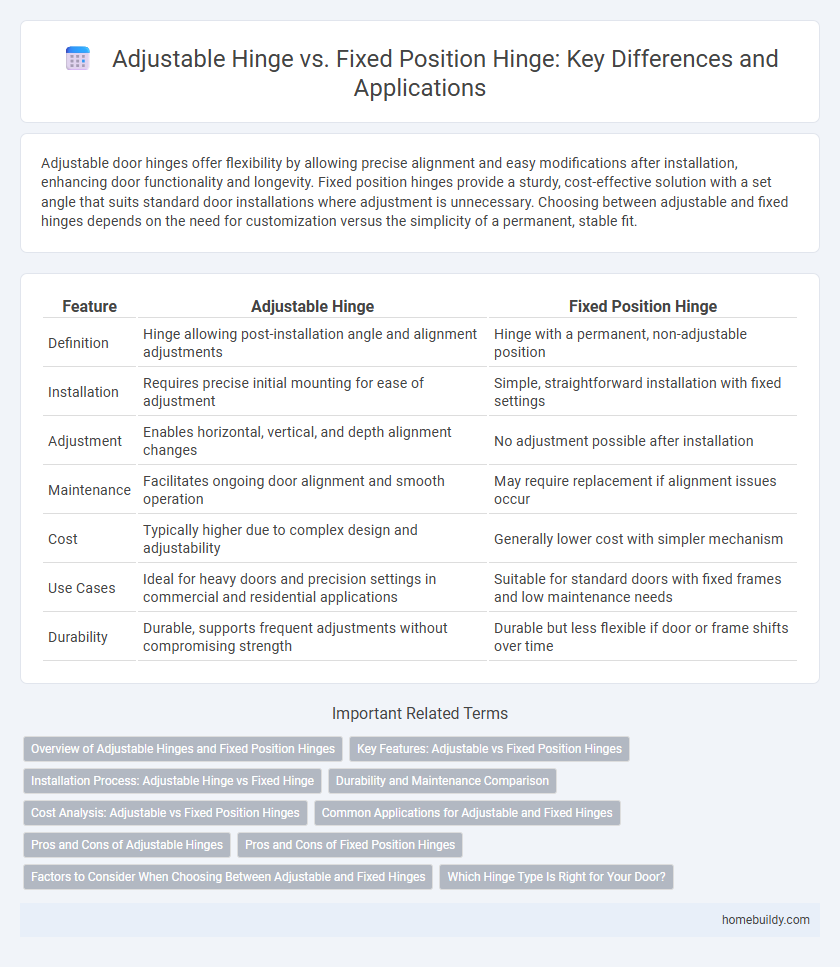Adjustable door hinges offer flexibility by allowing precise alignment and easy modifications after installation, enhancing door functionality and longevity. Fixed position hinges provide a sturdy, cost-effective solution with a set angle that suits standard door installations where adjustment is unnecessary. Choosing between adjustable and fixed hinges depends on the need for customization versus the simplicity of a permanent, stable fit.
Table of Comparison
| Feature | Adjustable Hinge | Fixed Position Hinge |
|---|---|---|
| Definition | Hinge allowing post-installation angle and alignment adjustments | Hinge with a permanent, non-adjustable position |
| Installation | Requires precise initial mounting for ease of adjustment | Simple, straightforward installation with fixed settings |
| Adjustment | Enables horizontal, vertical, and depth alignment changes | No adjustment possible after installation |
| Maintenance | Facilitates ongoing door alignment and smooth operation | May require replacement if alignment issues occur |
| Cost | Typically higher due to complex design and adjustability | Generally lower cost with simpler mechanism |
| Use Cases | Ideal for heavy doors and precision settings in commercial and residential applications | Suitable for standard doors with fixed frames and low maintenance needs |
| Durability | Durable, supports frequent adjustments without compromising strength | Durable but less flexible if door or frame shifts over time |
Overview of Adjustable Hinges and Fixed Position Hinges
Adjustable hinges offer precise alignment capabilities through mechanisms that allow vertical, horizontal, and depth adjustments, ensuring optimal door fit and function over time. Fixed position hinges provide a stable, non-movable pivot point, suitable for applications where door alignment remains constant and minimal maintenance is preferred. The choice between adjustable and fixed hinges depends on requirements for flexibility in door installation and future realignment needs.
Key Features: Adjustable vs Fixed Position Hinges
Adjustable door hinges offer precise alignment capabilities, allowing for fine-tuning of door height, depth, and lateral positioning to ensure perfect fit and smooth operation. Fixed position hinges provide a sturdy, reliable pivot point with a predetermined alignment suited for standard installations, offering simplicity and cost-effectiveness. The key feature distinguishing adjustable hinges is their flexibility in accommodating installation variances, while fixed hinges prioritize durability and straightforward application.
Installation Process: Adjustable Hinge vs Fixed Hinge
Installing an adjustable hinge requires precision in aligning multiple adjustment points to ensure smooth door movement and proper fit, often involving fine-tuning after mounting. Fixed position hinges have a simpler installation process, with fixed pivot points that demand accurate initial placement but no subsequent adjustments. The installation time for adjustable hinges is typically longer due to their complexity, while fixed hinges are faster to install but offer less flexibility in alignment corrections.
Durability and Maintenance Comparison
Adjustable door hinges offer superior durability by allowing fine-tuning to reduce stress and wear on the door frame, extending the lifespan of both the hinge and door components. Fixed position hinges, while generally simpler, can experience quicker wear due to misalignment and lack of adjustment options, leading to more frequent maintenance or replacement. Regular maintenance of adjustable hinges involves occasional tightening and lubrication, whereas fixed hinges may require more frequent repairs to address sagging or sticking issues.
Cost Analysis: Adjustable vs Fixed Position Hinges
Adjustable hinges typically cost more upfront than fixed position hinges due to their complex design and enhanced functionality, allowing for easy alignment and repositioning without replacing hardware. Fixed position hinges are generally less expensive and simpler to manufacture, making them cost-effective for basic applications but may incur higher labor costs over time if door adjustments are needed. Long-term savings from adjustable hinges arise from reduced maintenance and installation time, especially in commercial or frequently used door systems.
Common Applications for Adjustable and Fixed Hinges
Adjustable hinges are commonly used in residential and commercial doors requiring precise alignment, such as heavy entry doors and glass panel installations, where flexibility during installation and maintenance is essential. Fixed position hinges are ideal for applications with stable frames like interior doors, cabinetry, and lightweight doors that do not demand frequent adjustments. Both hinge types cater to specific needs based on door weight, material, and usage frequency, optimizing door performance and longevity.
Pros and Cons of Adjustable Hinges
Adjustable door hinges offer the advantage of precise alignment, enabling easy correction of door sagging or misalignment without removing the door, which enhances long-term functionality and reduces maintenance costs. However, they tend to be more complex and expensive compared to fixed position hinges, and their mechanical components can wear out over time, potentially requiring replacement. Fixed position hinges provide a simpler, more durable solution but lack the flexibility to adjust door positioning after installation.
Pros and Cons of Fixed Position Hinges
Fixed position hinges provide strong, stable support for doors, ensuring consistent alignment and reducing maintenance needs. The inflexibility of fixed hinges limits adjustments after installation, which can lead to issues if the door frame shifts or settles over time. Their durability and cost-effectiveness make them ideal for applications where door alignment is unlikely to change.
Factors to Consider When Choosing Between Adjustable and Fixed Hinges
Choosing between adjustable and fixed position door hinges depends on key factors such as alignment precision, installation complexity, and maintenance requirements. Adjustable hinges offer flexibility for fine-tuning door alignment post-installation, ideal for doors prone to settling or warping. Fixed hinges provide sturdy, low-maintenance support but require precise measurements and stable framing to ensure proper door function.
Which Hinge Type Is Right for Your Door?
Adjustable door hinges offer flexibility by allowing precise alignment and easy compensation for door frame irregularities, making them ideal for heavy or frequently used doors. Fixed position hinges provide a more straightforward installation with a robust, permanent attachment, best suited for standard doors where adjustments are rarely needed. Choosing the right hinge depends on door weight, usage frequency, and the need for future adjustments to ensure optimal door performance and longevity.
adjustable hinge vs fixed position hinge Infographic

 homebuildy.com
homebuildy.com